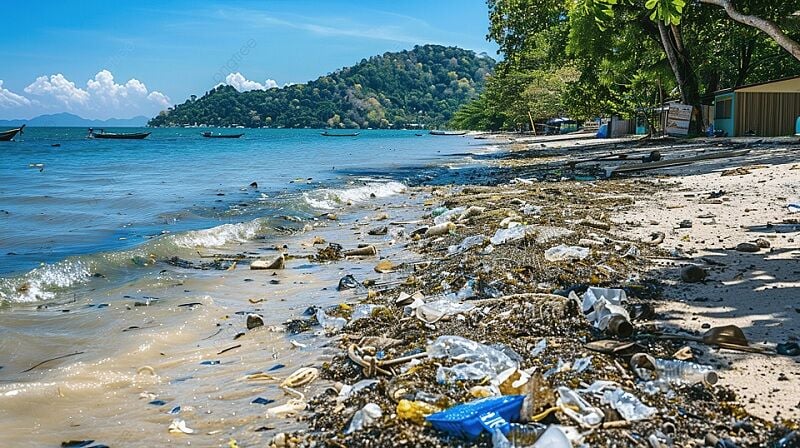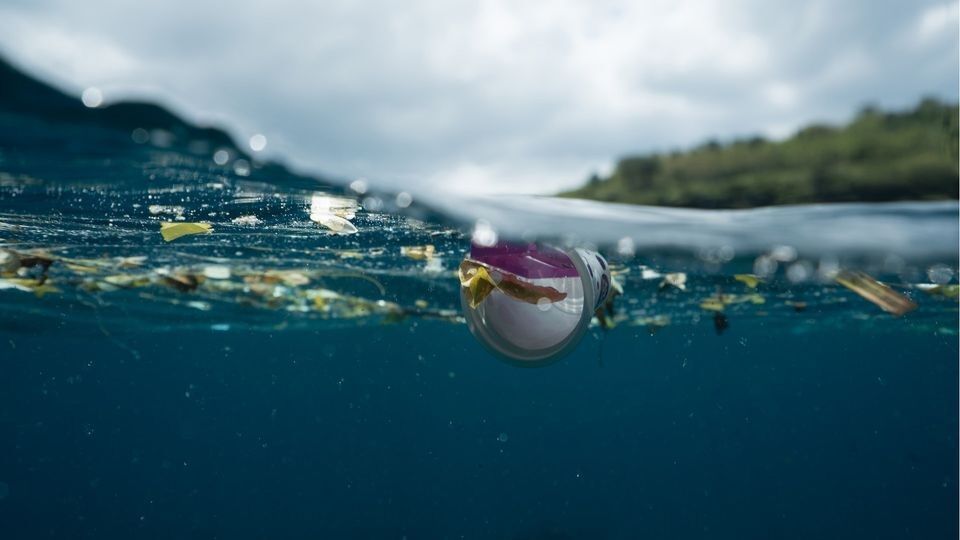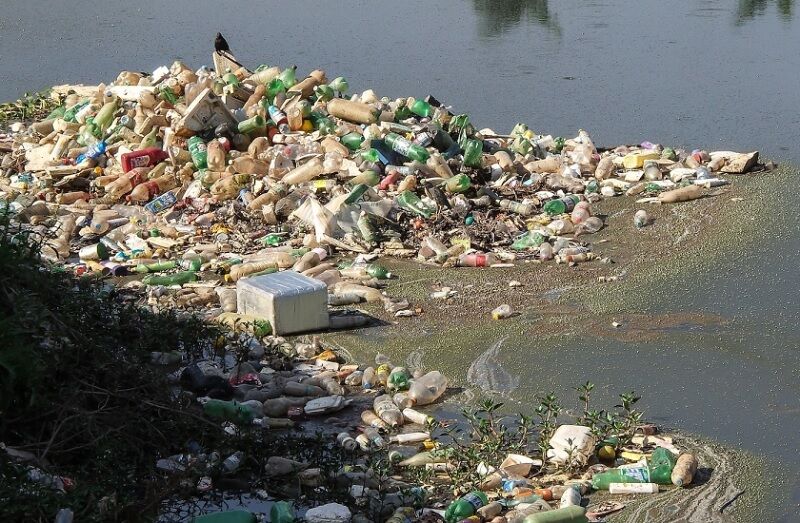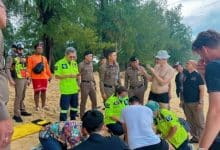Plastic pollution at the Thai beaches

Picture a stroll on Thailand’s beautiful coastline, feeling the fine grains of sand between your toes and the spectacle of the setting sun on the horizon. However, an alarming reality juxtaposes this idyllic scene – the sight of plastic waste littering the stretch of sand, a picture that starkly contrasts the otherwise natural beauty. This unsettling image reflects the magnitude of the plastic pollution crisis in Thailand, a situation that has expanded to cause considerable concerns.
At the helm of this escalating problem, local entities such as Trash Hero and EcoThailand have bravely accepted the responsibility, striving tirelessly to address the issue. Their plan of action includes beach clean-up drives, awareness workshops, and offering tips for more effective waste management. Yet, in spite of these commendable initiatives, the influx of plastic waste remains unabated.
Thailand was identified as the tenth largest contributor to marine plastic pollution globally in 2020, highlighting the vast extent of this environmental problem. Although the daily per capita consumption of plastic among the Thai population is lower compared to Western nations, Thailand astonishingly generates an annual total of 2.5 million tons of plastic waste. This preface provides an initial insight into the severe plastic pollution crisis that is impacting Thailand’s coastal beauty.
Scope of plastic pollution in Thai beaches
Diving into the details of plastic pollution in Thailand will unveil a disturbing array of statistics and impacts. It directly affects tourism and local communities and also threatens the beautiful image Thailand has as a tourist destination.
Current statistics and trends
Unleashing the grim reality, Thailand is estimated to be the sixth-largest global contributor to marine plastic, as stated by a study by Marks et al., 2020. Moreover, Norway’s salmon exporters seem to contribute to the problem significantly, producing approximately 6.5 million styrofoam boxes every year. These boxes typically end up as waste on Thai beaches like Koh Samui, causing a severe environmental impact. Regrettably, despite the EPS association’s claim that 80% of these boxes are recycled, on-ground observations in places like Koh Samui show otherwise.
Impact on tourism and local communities
The effect of plastic pollution on tourism and local communities is undeniable. One prime example is the Clean the Beach Boot Camp, a unique initiative promoting beach workouts to attract tourists. Participants gain fitness benefits while also contributing to beach cleanliness by picking up litter post-workout. This initiative, among others, demonstrates how local communities and tourists are stepping up and confronting the horrifying plastic pollution at the Thai Beaches. On the darker end, the increasing plastic pollution, visible in places like Koh Samui and Rayong, potentially threatens Thailand’s reputation as a pristine tourist destination.
In Rayong, a province known for its tourism and a 100-kilometre-long coastline, the issue is even more pressing. Hosting both an industrial hub and tourist hotspots, this region experiences intense plastic pollution, straining the ecological security of its shoreline. This province attracted approximately 7.7 million tourists in 2018, reflecting the potential detrimental impact on tourism if plastic pollution continues unchecked.
Sources of plastic pollution

Heading into the heart of the topic, it’s vital to unravel the leading contributors to plastic pollution at Thai beaches. Examining primary sources of waste provides a more comprehensive understanding of the situation and aids in formulating effective pollution reduction strategies.
Local contributions
Plastic pollution at the Thai beaches isn’t a standalone problem, it’s a part of a bigger global environmental issue. A significant portion of it is traceable back to land-based activities. We’re speaking about waste generated through everyday household items, packaging materials, and industrial products.
Storms, high winds, and ocean littering all play a part in carrying waste from inland areas into the marine environment. In addition, runoff from lands and municipal solid waste unknowingly contribute to plastic accumulation on the shores. Industrial activities and mismanaged wastes introduce another dimension to this issue, creating a significant environmental problem that Thailand now faces.
Tourist-generated waste
Let’s turn our attention now to another pivotal contributor to plastic waste: tourism. Thailand’s expansive and beautiful beachfront is irresistible to tourists worldwide. The downside? Some holidaymakers leave more than footprints on the sand.
Many beaches become littered with single-use plastic items, left behind post-vacation. Organisations like Clean the Beach Boot Camp offer a unique solution to tackle this. They offer free beach workouts, with one catch: participants must volunteer for beach cleaning post-workout (Clean the Beach Boot Camp). Practical solutions like these, encouraging tourists to engage in environmental cleanliness, can undoubtedly contribute to reducing the plastic pallet that blights the beauty of Thai beaches.
However, remember: plastic pollution at Thai beaches is not simply a local or tourist problem. This issue is a global concern, demanding cooperative, global solutions. Stakes are high with our precious marine ecosystems on the line, and curbing plastic pollution in all forms remains an environmental priority.
Environmental impact

Effects on marine life
Plastic pollution poses severe threats to marine life due to both its physical presence and the host of chemicals it introduces into the ecosystem. Marine organisms face risks including intestinal blockage, tissue abrasion, and metabolic interference caused by plastic ingestion. Ironically, these minute pollutants serve as vectors, transferring chemicals from environments to organisms – quite a devastating blow from a source so tiny.
For instance, studies show a significant relationship between microplastics and trace elements such as Cr, Mn, Fe, Cd, Hg, and As in commercial fish from the Gulf of Mannar, Indian Ocean in Southern India.
Consequences for beach ecosystems
Let’s speak about Thailand, specifically the paradise that used to be Koh Samui. Today, a distressing sight greets you – a coastline littered with discarded Styrofoam boxes, widely used by Norwegian fish exporters. These boxes, difficult to recycle locally due to wind dispersal and the presence of unprocessable colour pigments, contribute significantly to ecosystem degradation in areas like Koh Samui.
Images from Koh Samui underscore an environmental impact that is becoming painfully evident. At a local sorting centre, Anusit Srisra voices his frustration over the challenges posed by this foreign waste.
It’s clear that the implications of plastic pollution on beaches run deeper than a simple eyesore. The degradation of these ecosystems could spell disaster for local wildlife and destabilise the balance of these delicate environments.
Efforts towards mitigation

Dedicated to halting the plastic pollution at the Thai beaches, many are rising to the task, driven by a sense of responsibility and inspiration. Let’s explore these aspects further under two key categories government initiatives and community-led cleanup efforts.
Government initiatives
Thailand’s government isn’t taking this ecological disaster lightly. Rayong province, renowned for its 100-km long coastline, not only serves as Thailand’s industrial hub but has also morphed into a centre for the petrochemicals sector. This progress, however, extends beyond mere economic growth. According to Marks et al. (2020), Thailand currently ranks as the sixth-largest global contributor to marine plastic. To counteract this, governmental efforts are underway to transform plastic waste management practices. One such endeavour is the adoption of the circular economy model, advocated by the Ellen MacArthur Foundation. This model redefines growth, focusing on positive societal benefits such as eliminating waste through the superior design of materials, products, and systems.
Community-led cleanup efforts
Arguably, the heart and soul of these efforts, however, lie with the local communities. Entities like the Clean the beach boot camp have taken a novel approach by appealing to Thailand’s visitors. As you partake in a free workout on the beach – you’re expected to give back. As part of this initiative, participants volunteer to clean waste from the beach after their workout. Commercial businesses, too, bear a responsibility. With consumers holding companies accountable for preventing and cleaning up waste from plastic products, businesses are slowly but surely stepping up. Even with their combined efforts, the task remains monumental. After all, it’s not just about curbing plastic waste but reversing the years of damage that we’ve inflicted upon Thailand’s beaches.
The serious implications of plastic pollution on the pristine shores of Thailand call for immediate and collective action. The commendable efforts of organisations such as trash hero, EcoThailand, and clean the beach boot camp are a testament to the fact that constructive transformation is indeed possible. These bodies attack the problem head-on, conducting comprehensive beach clean-ups to implementing educational initiatives, ultimately contributing to palpable results. However, the responsibility does not merely fall on their shoulders. It is the duty of each individual, including tourists and indigenous communities, to actively participate in these efforts. With the advent of the circular economy model implemented by the Thai government, there lies potential for a more sustainable framework for managing plastic waste.
Want to know more, Old cars fuel pollution crisis, electric vehicles offer a cleaner future. In the intricate ecosystems of urban areas and extensive highway networks, the environmental implications of vehicular traffic demand immediate attention. It is critical to recognise the significant contribution of motor vehicles to air pollution, an issue that has become glaringly evident. The emissions from vehicles, whether for daily commutes or longer travels, considerably increase atmospheric pollution with deleterious substances.
Latest Thailand News
Follow The Thaiger on Google News:


























